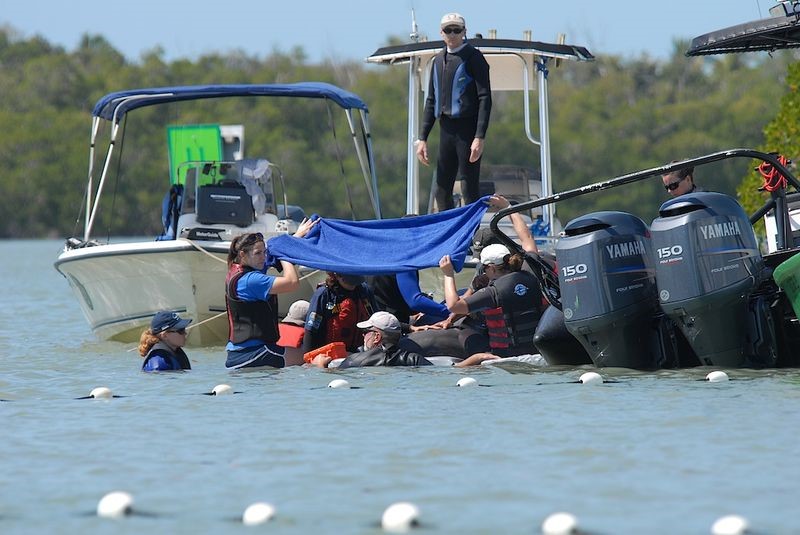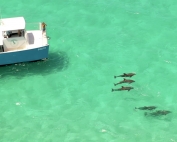Finally!

This website has been a long time in arriving.
It was a cool morning way back in January of 2006 that Chris Desmond and I recorded our first dolphin sighting after launching The 10,000 Island Dolphin Project. We were learning as we went along.
Chris had conceived the idea of an eco-tour that would be built around a photo-identification study of the bottlenose dolphins in the area about which little was known. I certainly didn’t know anything about them having recently transplanted to Florida after working as a naturalist in Southeast Alaska. Nor were either of us trained scientists.
Nonetheless the idea that we could, through our own careful observation and recording, slowly reveal the world of these dolphins captured our imagination.
My mom and some of her friends came along on that first trip as our guinea pigs to test the concept. We dropped a sechi disc in the water to measure turbidity, a thermometer to measure water temperature and together went through the motions of trying to figure out the proper use of a refractometer to measure the salinity level.

My mom lowers a sechi disc into the water to measure turbidity
That first group of dolphins we saw included a mom and calf that we called Halfway and Seymour. Two big males we named Sharks and Oscar in memory of my dad (his nickname was Sharks) and the father of my mom’s friends both of who had recently passed.
That moment was a revelation – these four dolphins were no longer generic representatives of the species Tursiops truncatus; they were individuals and members of a community.
The notes from that sighting were simple: “apparently feeding in very shallow water along the edge of mangroves and mudflats. One very young dolphin”.
That was now the entirety of our knowledge. 5 dolphins at these coordinates were apparently feeding at low tide in 1-5 feet of water and one of them was really small.

Oscar and Sharks in very shallow water working the mangrove fringe.
It wasn’t that we were putting a puzzle together. It was that with each sighting we were bringing into existence another puzzle piece. Then another recorded sighting with photos and the shape of a second piece is cut and filled with colors. Each tantalizing piece makes you hungry for another.
Here we are 14 years later – Halfway is a grandmother! – and the research continues, now under the auspices of The Dolphin Study, a 501(c)(3) nonprofit. We have over 12,000 of these pieces and – oh yeah I am sticking with the ol puzzle metaphor – now they are splayed out, most of the border is put together and, while sections are nicely filled in, there is a long way to go to complete the picture.
That’s where you find us now as we invite you to join in getting to know these communities of dolphins. We have learned a lot, especially in Area One near The Big Marco Pass where most of our survey work was conducted. We have identified most of the individual dolphins, figured out which ones are male, which are female, gotten a sense of their range, reproductive patterns, feeding habits etc.
But we are still learning more. Consider everything you read here as a working hypothesis subject to refinement as new information comes in. Just the other day we photographed a group of dolphins near Cape Romano south of Marco. Some of our regulars from the northern end of Marco appeared, expanding our understanding of their home range by several miles.

Halfway, now a grandmother, gets a playful nip from her calf Wyatt.
Well, you are part of the team now. With this website you can come to know and track each of the dolphins in the communities from Sanibel Island to Everglades City. You can follow them from birth, watch as they become young sub-adults then mature, give birth and raise calves of their own. If you are so inclined, you can pour over the colored shapes that emerge from the sighting data and work with us to fashion a coherent picture of the dolphins of Southwest Florida.
And then join us in the important work of ensuring that the dolphins that you come to know and admire here can continue to thrive. Coastal bottlenose dolphins in Florida are facing multiple threats to their well-being.

October 2010 – Wounds from a boat propeller heal on Shark’s side.
Consider just the four dolphins from the sighting described here. In 2010 Oscar’s side was sliced by a boat propeller; his partner Sharks leapt into a recreational boat and remained there until the fire department was able to get him back in the water.

Oscar out of his element, March 2010 – Marco Eagle
A full-scale intervention had to be mounted for Seymour who suffered a life-threatening entanglement in fishing line. Halfway had a second calf (Skipper) and a grandchild (Ariel) that also experienced entanglements and interventions. While the potential for entanglement in fishing line and boat strikes impact individual dolphins, toxins, red tides blooms and the climate crisis impact entire communities.

March 9, 2012 – The stranding network works to remove fishing line cutting into Seymour’s tail.
Here at The Dolphin Study, we will continue to provide as complete a picture as possible of the communities of dolphins in our midst. We will highlight threats to their health and point to behaviors and policies that will ensure they can continue to thrive. We look forward to partnering with you in advocating for these amazing neighbors of ours.
How Far Do Our Local Dolphins Travel?
How Far Do the Dolphins of Naples and Marco Island Travel ? Insights on their [...]
Another Dolphin Birth: Lulu Arrives to Join The Local Community
It seems we have yet to see the end of birthing season for the dolphins [...]
The Importance of Being Skipper
The Importance of Being Skipper With the recent birth of her calf, Skipper's 2014 rescue [...]
Honest Eco in Key West: A Model for Ecotours
I Have Beheld the Future Honest Eco in Key West Sets the Standard for ethical [...]
Marco Island’s Bottlenose dolphin birthing season has begun
A local bottlenose dolphin mother and her daughter approach the birthing season together This [...]
How Many Dolphins Live Around Marco Island and How Are They Distributed
How Many Dolphins Live Around Marco Island? The results of 150 new boat-based [...]





